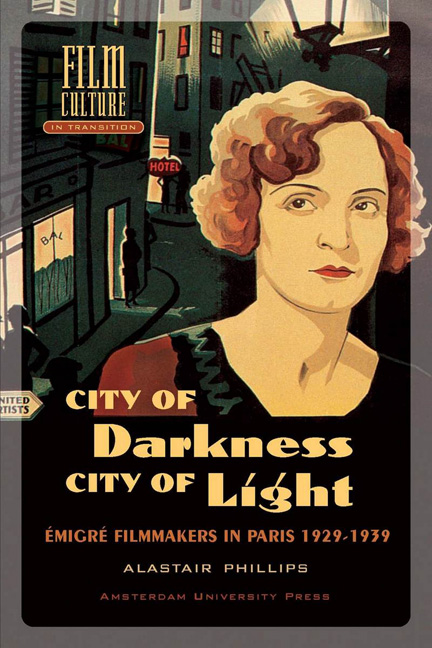Book contents
- Frontmmatter
- Contents
- Acknowledgements
- Chapter One Introduction
- Chapter Two The City in Context: An Historical Ambivalence
- Chapter Three City of Light: Paris as Spectacle
- Chapter Four City of Darkness: The Camera Goes Down the Streets: ‘The Hidden Spirit Under the Familiar Façade’
- Chapter Five Divided City: The Divided City in Context
- Chapter Six Conclusion
- Notes
- Appendices
- Filmography
- Bibliography
- Index
- Film Culture in Transition General Editor: Thomas Elsaesser
Chapter One - Introduction
Published online by Cambridge University Press: 25 January 2021
- Frontmmatter
- Contents
- Acknowledgements
- Chapter One Introduction
- Chapter Two The City in Context: An Historical Ambivalence
- Chapter Three City of Light: Paris as Spectacle
- Chapter Four City of Darkness: The Camera Goes Down the Streets: ‘The Hidden Spirit Under the Familiar Façade’
- Chapter Five Divided City: The Divided City in Context
- Chapter Six Conclusion
- Notes
- Appendices
- Filmography
- Bibliography
- Index
- Film Culture in Transition General Editor: Thomas Elsaesser
Summary
“With cities, it is as with dreams: everything imaginable can be dreamed, but even the most unexpected dream is a rebus that conceals a desire or, its reverse, a fear”.
(Italo Calvino 1974, 44)Diversity and Exchange – Rethinking the National in European Cinema
In 1931, the French painter Maurice Vlaminck wrote that he now tended to “avoid going to Paris. It has become for me like a train station, a kind ofWestern Constantinople, a junction [and] a bazaar” (in Golan 1995, 88). Vlaminck's acerbic description of the bustling and cosmopolitan nature of Parisian life points to the fact that the French capital did indeed become a terminus or junction for various groups of émigrés in the 1930s. Among the people drawn to the possibilities of the City of Light were a succession of European filmmakers who arrived in Paris from the internationally successful studios of Berlin. Some like Fritz Lang and Billy Wilder stayed only a brief time. The director Robert Siodmak, on the other hand, ended up working in France for a number of years. This book looks at the significance of this moment in film history through a detailed analysis of the émigrés’ various on- and off-screen relationships with their adopted home.
“Home” is not the correct word. The truth is that many of these émigrés were displaced figures on a journey that remained, as it must always be for the exile, both “composite and evolutionary” (Naficy 2001, 222). The time that filmmakers such as Wilder, Lang and Siodmak spent in Paris, in what fellow émigré Siegfried Kracauer has termed “the near vacuum of extraterritoriality” (in Koch 1991,105), was, for many, but one episode of a larger trajectory. To extend the railway analogy, Paris was a “waiting room” (Elsaesser 1984, 278): a place of temporary refuge before their journey onwards to the more rewarding terrain of Hollywood. Because of the glamour of this final destination, and despite the fact that the émigré filmmakers clearly made a significant contribution to French cinema, there is still little written in English about this unique and fascinating phenomenon. My book seeks to redress this imbalance. To examine the cinematic representation of Paris by émigré filmmakers in the French cinema of the 1930s means to engage with the ways in which European national cinemas are currently being reconceptualized as discrete discursive and economic phenomena.
- Type
- Chapter
- Information
- City of Darkness, City of LightÉmigré Filmmakers in Paris 1929–1939, pp. 9 - 20Publisher: Amsterdam University PressPrint publication year: 2003

